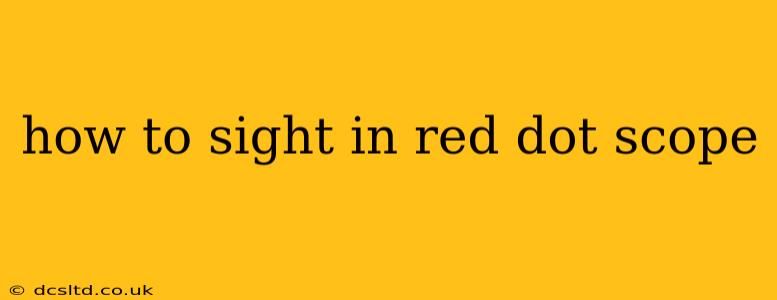Sighting in a red dot scope might seem daunting at first, but with the right approach and patience, it's a straightforward process. This guide will walk you through each step, ensuring you're accurately zeroed in and ready for your next shooting session. Whether you're a seasoned shooter or a newcomer to optics, understanding the fundamentals of red dot sight adjustment is crucial for optimal performance.
What is Zeroing a Red Dot Sight?
Zeroing, or sighting in, your red dot scope means adjusting its internal mechanisms to align the point of impact (where the bullet hits) with the point of aim (where the red dot is positioned on your target). This ensures your shots land precisely where you intend them to. A properly zeroed red dot scope is essential for accuracy and consistent results.
Tools You'll Need
Before you begin, gather the necessary equipment:
- Your firearm: Ensure it's unloaded and safely handled throughout the process.
- Your red dot sight: Make sure it's securely mounted on your firearm.
- Ammunition: Use the same type and brand of ammunition you plan to use regularly.
- Target: A clearly marked target at your chosen distance (typically 25 yards to start).
- Shooting Rest (Optional but Recommended): A shooting rest helps reduce human error and provides a more stable shooting platform.
- Safety Glasses and Ear Protection: Always prioritize safety.
- Screwdrivers: You'll need the correct size screwdrivers to adjust the windage and elevation knobs on your red dot sight. Consult your sight's manual for details.
Step-by-Step Guide to Sighting In Your Red Dot Scope
1. Setting Up Your Shooting Range:
- Choose a safe, controlled environment for shooting.
- Set up your target at your chosen distance (25 yards is a common starting point). Ensure the target is clearly visible.
- Securely place your firearm on a shooting rest (if using one).
2. Initial Aim and First Shot:
- Load your firearm according to its instructions.
- Aim carefully at the center of your target using the red dot as your aiming point.
- Fire one shot.
3. Assessing Your First Shot:
- Carefully examine your target to determine where your shot landed relative to the center. Note the distance and direction of the miss.
4. Making Adjustments:
Most red dots use a system of adjustments measured in MOA (Minutes of Angle) or clicks. Each click will move the point of impact a certain amount (usually 1/4 MOA or 1/2 MOA). Consult your sight's manual to understand its specific adjustments and how many clicks equal one inch at your chosen distance.
- Windage (Left/Right): Adjust the windage knob to correct for horizontal errors. A shot to the right requires turning the windage knob to the right (or clockwise, depending on the sight). A shot to the left requires adjusting the knob to the left (or counterclockwise).
- Elevation (Up/Down): Adjust the elevation knob to correct for vertical errors. A shot below the center requires turning the elevation knob up, and a shot above the center requires turning it down.
5. Iterative Adjustments:
- After making adjustments, fire another shot and re-evaluate. Continue this process, making smaller and smaller adjustments, until your shots consistently hit the center of the target. Usually, 3-5 shots is sufficient.
6. Checking Zero at Longer Ranges:
Once you've zeroed your red dot at 25 yards, you can test the zero at longer ranges (e.g., 50 yards, 100 yards). Minor adjustments may be required at longer distances due to bullet drop.
Frequently Asked Questions (FAQs)
How often should I sight in my red dot scope?
You should sight in your red dot scope whenever you change ammunition, significantly alter your firearm (e.g., adding accessories), or if you notice your point of impact shifting significantly.
What if my red dot is still off after several adjustments?
If you're still having trouble zeroing your red dot, there may be an issue with the sight itself, its mounting, or even your shooting technique. Check for any loose screws or damaged parts. If the problem persists, seek assistance from a professional gunsmith.
Can I sight in my red dot scope at home?
While you can sight in your red dot at home, it's crucial to do so safely and responsibly. Ensure you have a safe backstop, a controlled environment, and appropriate safety measures in place.
What's the difference between MOA and clicks?
MOA (Minutes of Angle) is a unit of angular measurement, while clicks refer to the incremental adjustments made using the windage and elevation knobs on your red dot scope. The relationship between MOA and clicks varies depending on the specific sight.
By following these steps and addressing common questions, you'll be well on your way to accurately sighting in your red dot scope and enjoying improved accuracy on the range. Remember to always prioritize safety and consult your firearm and red dot sight manuals for specific instructions.
